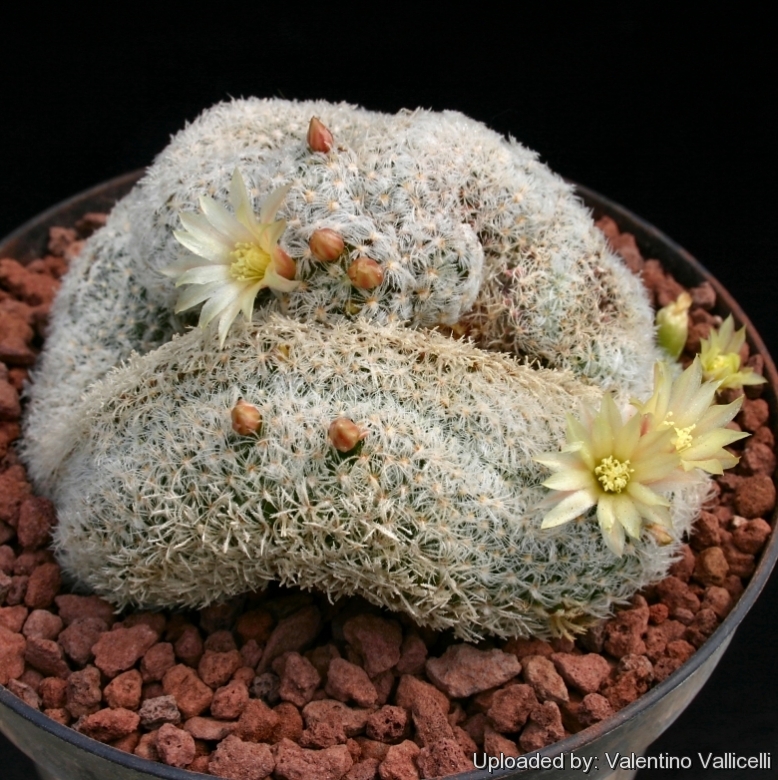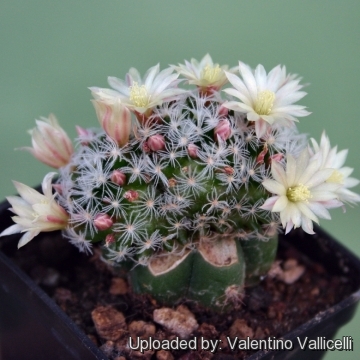Donate now to support the LLIFLE projects.
Your support is critical to our success.
Your support is critical to our success.
Accepted Scientific Name: Mammillaria crinita subs. duwei (Rogoz. & P.J.Braun)
[Basionym: Mammillaria duwei Rogoz. & P.J.Braun 1985]

Mammillaria crinita subs. duwei f. cristata Photo by: Valentino Vallicelli
Synonyms:
See all synonyms of Mammillaria crinita
back
Accepted name in llifle Database:Mammillaria crinita DC.
Mém. Mus. Hist. Nat. 17: 112. 1828
Synonymy: 50
- Mammillaria crinita DC.
- Cactus crinitus (DC.) Kuntze
- Chilita crinita (DC.) Buxb.
- Ebnerella crinita (DC.) Buxb.
- Krainzia crinita (DC.) Doweld
- Mammillaria glochidiata var. crinita (DC.) K.Schum.
- Mammillaria glochidiata f. crinita (DC.) Schelle
- Mammillaria aureoviridis Heinrich
- Mammillaria brevicrinita Repp.
- Mammillaria cadereytana Backeb.
- Mammillaria calleana Backeb.
- Mammillaria criniformis DC.
- Chilita criniformis (DC.) Buxb.
- Mammillaria criniformis var. albida DC.
- Mammillaria erectohamata Boed.
- Chilita erectohamata (Boed.) Buxb.
- Ebnerella erectohamata (Boed.) Buxb.
- Mammillaria felipensis Repp.
- Mammillaria gilensis Boed.
- Chilita gilensis (Boed.) Buxb.
- Ebnerella gilensis (Boed.) Buxb.
- Mammillaria glochidiata var. xiloensis Repp.
- Mammillaria moeller-valdeziana Appenz.
- Mammillaria mollihamata Shurly
- Mammillaria puberula Repp.
- Mammillaria pubispina Boed.
- Chilita pubispina (Boed.) Buxb.
- Ebnerella pubispina (Boed.) Buxb.
- Mammillaria pygmaea (Britton & Rose) A.Berger
- Chilita pygmaea (Britton & Rose) Buxb.
- Ebnerella pygmaea (Britton & Rose) Buxb.
- Neomammillaria pygmaea Britton & Rose
- Mammillaria scheinvariana R.Ortega V. & Glass
- Mammillaria crinita subs. scheinvariana (R.Ortega V. & Glass) W.A.Fitz Maur. & B.Fitz Maur.
- Mammillaria schelhasii Pfeiff.
- Cactus schelhasii (Pfeiff.) Kuntze
- Chilita schelhasii (Pfeiff.) Orcutt
- Ebnerella schelhasii (Pfeiff.) Buxb.
- Mammillaria schelhasei Pfeiff. Pfeiff.
- Neomammillaria schelhasii (Pfeiff.) Britton & Rose
- Mammillaria schelhasii var. triuncinata Salm-Dyck
- Mammillaria schelhasei f. triuncinata (Salm-Dyck) Schelle
- Mammillaria tezontle W.A.Fitz Maur. & B.Fitz Maur.
- Mammillaria variabilis Repp.
- Mammillaria zeilmanniana Boed.
- Chilita zeilmanniana (Boed.) Buxb.
- Ebnerella zeilmanniana (Boed.) Buxb.
- Mammillaria crinita f. zeilmanniana (Boed.) Glass
- Neomammillaria zeilmanniana (Boed.) Y.Itô
- Mammillaria zeilmanniana f. albiflora hort.
Mammillaria crinita subs. duwei (Rogoz. & P.J.Braun)
[Basionym: Mammillaria duwei Rogoz. & P.J.Braun 1985]
Synonymy: 10
- Mammillaria crinita subs. duwei (Rogoz. & P.J.Braun)
- Mammillaria duwei Rogoz. & P.J.Braun
- Mammillaria nana subs. duwei (Rogoz. & P.J.Braun) Pilbeam
- Mammillaria trichacantha subs. duwei (Rogoz. & P.J.Braun) Mottram
- Mammillaria crinita subs. duwei f. cristata hort.
- Mammillaria crinita subs. duwei f. inermis hort.
- Mammillaria crinita subs. duwei f. monstruosa hort.
Mammillaria crinita subs. leucantha (Boed.) D.R.Hunt
Mammillaria Postscripts 6: 6 (1997)
Synonymy: 8
- Mammillaria crinita subs. leucantha (Boed.) D.R.Hunt
- Krainzia crinita subs. leucantha (Boed.) Doweld
- Mammillaria leucantha Boed.
- Mammillaria aurihamata Boed.
- Chilita aurihamata (Boed.) Buxb.
- Ebnerella aurihamata (Boed.) Buxb.
- Mammillaria schelhasii var. aurihamata (Boed.) Repp.
- Neomammillaria aurihamata (Boed.) Y.Itô
Mammillaria crinita f. nana (Backeb.)
[Basionym: Mammillaria nana Backeb. 1966 ]
Synonymy: 9
- Mammillaria crinita f. nana (Backeb.)
- Mammillaria nana Backeb.
- Mammillaria monancistracantha Backeb.
- Mammillaria rawlii hort.
- Mammillaria trichacantha K.Schum.
- Chilita trichacantha (K.Schum.) Buxb.
- Ebnerella trichacantha (K.Schum.) Buxb.
- Mammillaria nana trichacantha hort.
- Neomammillaria trichacantha (K.Schum.) Britton & Rose
Mammillaria crinita subs. painteri (Rose) U.Guzmán
Cactaceae Syst. Init. 16: 18 (11 Oct. 2003) Remarks: first published in U.Guzmán et al., Catálogo Cact. Mex.: 120 (May 2003), without basionym reference
Synonymy: 9
- Mammillaria crinita subs. painteri (Rose) U.Guzmán
- Chilita painteri (Rose) Buxb.
- Ebnerella painteri (Rose) Buxb.
- Mammillaria painteri Rose
- Neomammillaria painteri (Rose) Britton & Rose
- Mammillaria crinita subs. painteri f. monstruosa cristata hort.
- Mammillaria crinita subs. painteri f. monstruosa hort.
back

Mammillaria crinita subs. duwei f. cristata Photo by: Valentino Vallicelli
Send a photo of this plant.
The gallery now contains thousands of pictures, however it is possible to do even more. We are, of course, seeking photos of species not yet shown in the gallery but not only that, we are also looking for better pictures than those already present. Read More...
The gallery now contains thousands of pictures, however it is possible to do even more. We are, of course, seeking photos of species not yet shown in the gallery but not only that, we are also looking for better pictures than those already present. Read More...
| Your Actions | |
|---|---|
| Back to Mammillaria index | |
| Back to Cactaceae index | |
 |
Back to Cacti Encyclopedia index |








